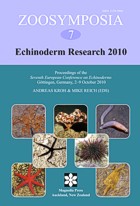Abstract
The rock burrowing sea urchin Paracentrotus lividus is a common wave-swept organism that inhabits intertidal rock pools and shallow subtidal temperate shores. Here we present field data on P. lividus attachment force, burrow shape and test diameter measured in different rocky habitats (intertidal pools, low shore intertidal channels and shallow subtidal shores) and in two study sites with different wave-exposure conditions. These data were then analyzed to look for a possible relationship between the size of sea urchins and their attachment force and burrow shape as well as the influence of wave-exposure and habitat in the measured variables. P. lividus test diameter varied among habitats: urchins were smaller in mid-shore intertidal pools and bigger in shallow subtidal shores. We observed in all studied habitats that attachment force was not correlated with test size, while burrow shape index (BSI) was negatively correlated with test size. Results suggest that the attachment force of large and small urchins was similar, but smaller animals occurred in relatively deeper burrows (higher BSI values). Attachment force was positively correlated with BSI, which indicates that burrows may enhance attachment force of P. lividus living in rocky shores by allowing the use of spines as anchorage points and reducing the urchin area exposed to drag forces. Our results partially support the hypothesis that attachment force and BSI might be influenced by local variation in wave-exposure. Higher values for both attachment strength and BSI were measured in intertidal rock pools, the most wave-exposed habitat considered in this study, suggesting that urchins living in such habitat are more able to resist dislodgment by wave-induced forces since they occupy relatively deeper burrows and thusattach more firmly to the substrate. However, neither attachment force nor BSI were higher in the more exposed shore.

